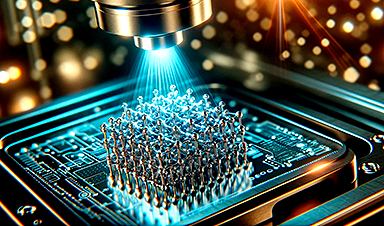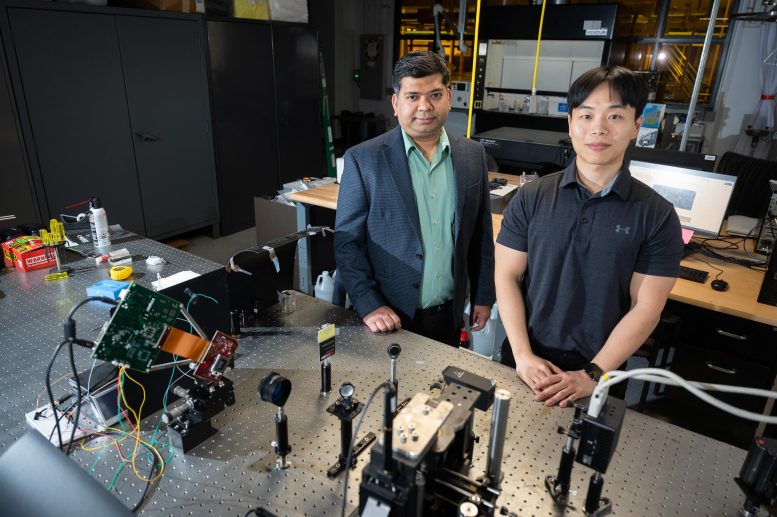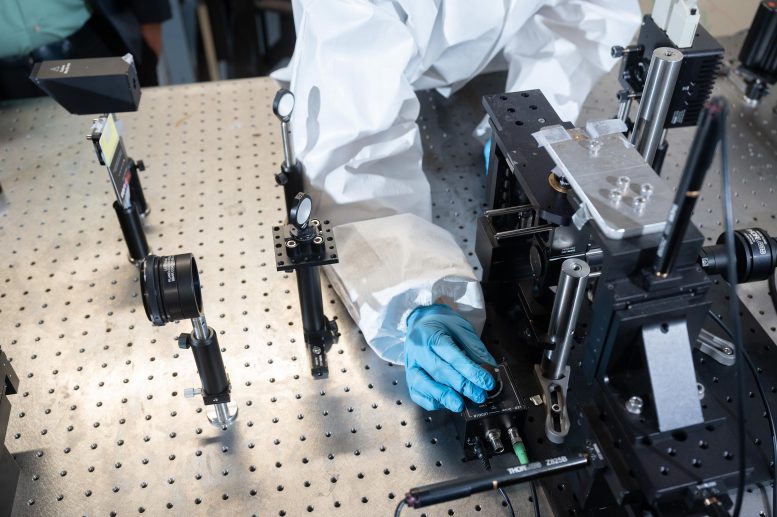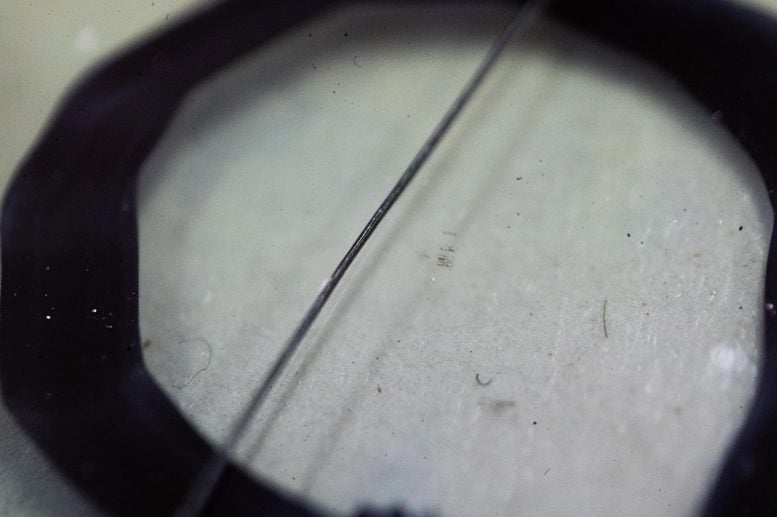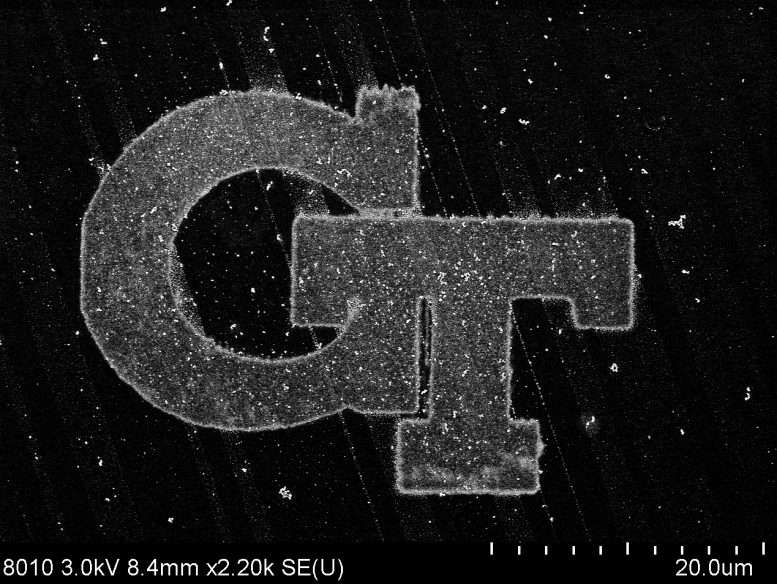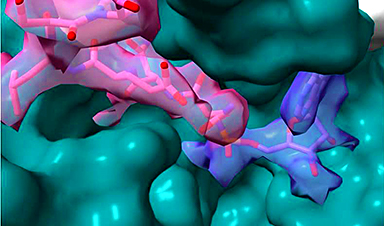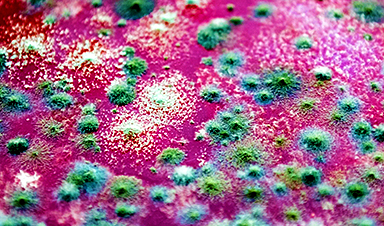Their technique could transform a scientific field reliant on cost-prohibitive technology.
Researchers at the Georgia Institute of Technology have developed a light-based means of printing nano-sized metal structures that is significantly faster and cheaper than any technology currently available. It is a scalable solution that could transform a scientific field long reliant on technologies that are prohibitively expensive and slow. The breakthrough has the potential to bring new technologies out of labs and into the world.
Advantages of the New Technique
Technological advances in many fields rely on the ability to print metallic structures that are nano-sized — a scale hundreds of times smaller than the width of a human hair. Sourabh Saha, assistant professor in the George W. Woodruff School of Mechanical Engineering, and Jungho Choi, a Ph.D. student in Saha’s lab, developed a technique for printing metal nanostructures that is 480 times faster and 35 times cheaper than the current conventional method.
Their research was published in the journal Advanced Materials.
Assistant Professor Sourabh Saha and Jungho Choi (Ph.D. student) in front of their superluminescent light projection system at Georgia Tech. Credit: Georgia Institute of Technology
Overcoming Traditional Limitations
Printing metal on the nanoscale — a technique known as nanopatterning — allows for the creation of unique structures with interesting functions. It is crucial for the development of many technologies, including electronic devices, solar energy conversion, sensors, and other systems.
It is generally believed that high-intensity light sources are required for nanoscale printing. But this type of tool, known as a femtosecond laser, can cost up to half a million dollars and is too expensive for most research labs and small businesses.
“As a scientific community, we don’t have the ability to make enough of these nanomaterials quickly and affordably, and that is why promising technologies often stay limited to the lab and don’t get translated into real-world applications,” Saha said.
Ph.D. student Jungho Choi controlling LED brightness levels on the SLP system. Credit: Georgia Institute of Technology
“The question we wanted to answer is, ‘Do we really need a high-intensity femtosecond laser to print on the nanoscale?’ Our hypothesis was that we don’t need that light source to get the type of printing we want.”
They searched for a low-cost, low-intensity light that could be focused in a way similar to femtosecond lasers, and chose superluminescent light emitting diodes (SLEDs) for their commercial availability. SLEDs emit light that is a billion times less intense than that of femtosecond lasers.
A video of nanoprinting with superluminescent light projection (SLP). Credit: Georgia Institute of Technology
Innovative Printing Technology
Saha and Choi set out to create an original projection-style printing technology, designing a system that converts digital images into optical images and displays them on a glass surface. The system operates like digital projectors but produces images that are more sharply focused. They leveraged the unique properties of the superluminescent light to generate sharply focused images with minimal defects.
They then developed a clear ink solution made up of metal salt and added other chemicals to make sure the liquid could absorb light. When light from their projection system hit the solution, it caused a chemical reaction that converted the salt solution into metal. The metal nanoparticles stuck to the surface of the glass, and the agglomeration of the metal particles creates the nanostructures. Because it is a projection type of printing, it can print an entire structure in one go, rather than point by point — making it much faster.
Size comparison between human hair (~100 micrometer thickness) versus printed silver pad on a glass coverslip. Credit: Georgia Institute of Technology
After testing the technique, they found that projection-style nanoscale printing is possible even with low-intensity light, but only if the images are sharply focused. Saha and Choi believe that researchers can readily replicate their work using commercially available hardware. Unlike a pricey femtosecond laser, the type of SLED that Saha and Choi used in their printer costs about $3,000.
Applications
“At present, only top universities have access to these expensive technologies, and even then, they are located in shared facilities and are not always available,” Choi said. “We want to democratize the capability of nanoscale 3D printing, and we hope our research opens the door for greater access to this type of process at a low cost.”
The researchers say their technique will be particularly useful for people working in the fields of electronics, optics, and plasmonics, which all require a variety of complex metallic nanostructures.
Scanning electron microscope image of printed silver GT pattern Credit: Georgia Institute of Technology
“I think the metrics of cost and speed have been greatly undervalued in the scientific community that works on fabrication and manufacturing of tiny structures,” Saha said.
“In the real world, these metrics are important when it comes to translating discoveries from the lab to industry. Only when we have manufacturing techniques that take these metrics into account will we be able to fully leverage nanotechnology for societal benefit.”
Reference: “Scalable Printing of Metal Nanostructures through Superluminescent Light Projection” by Jungho Choi and Sourabh K. Saha, 22 October 2023,Advanced Materials.
DOI: 10.1002/adma.202308112
Funding includes grants from the G.W.W. School of Mechanical Engineering and the EVPR’s office at the Georgia Institute of Technology. Imaging was performed at the Georgia Tech Institute for Electronics and Nanotechnology, a member of the National Nanotechnology Coordinated Infrastructure (NNCI), which is supported by the National Science Foundation (ECCS-2025462).
News
Repurposed drugs could calm the immune system’s response to nanomedicine
An international study led by researchers at the University of Colorado Anschutz Medical Campus has identified a promising strategy to enhance the safety of nanomedicines, advanced therapies often used in cancer and vaccine treatments, [...]
Nano-Enhanced Hydrogel Strategies for Cartilage Repair
A recent article in Engineering describes the development of a protein-based nanocomposite hydrogel designed to deliver two therapeutic agents—dexamethasone (Dex) and kartogenin (KGN)—to support cartilage repair. The hydrogel is engineered to modulate immune responses and promote [...]
New Cancer Drug Blocks Tumors Without Debilitating Side Effects
A new drug targets RAS-PI3Kα pathways without harmful side effects. It was developed using high-performance computing and AI. A new cancer drug candidate, developed through a collaboration between Lawrence Livermore National Laboratory (LLNL), BridgeBio Oncology [...]
Scientists Are Pretty Close to Replicating the First Thing That Ever Lived
For 400 million years, a leading hypothesis claims, Earth was an “RNA World,” meaning that life must’ve first replicated from RNA before the arrival of proteins and DNA. Unfortunately, scientists have failed to find [...]
Why ‘Peniaphobia’ Is Exploding Among Young People (And Why We Should Be Concerned)
An insidious illness is taking hold among a growing proportion of young people. Little known to the general public, peniaphobia—the fear of becoming poor—is gaining ground among teens and young adults. Discover the causes [...]
Team finds flawed data in recent study relevant to coronavirus antiviral development
The COVID pandemic illustrated how urgently we need antiviral medications capable of treating coronavirus infections. To aid this effort, researchers quickly homed in on part of SARS-CoV-2's molecular structure known as the NiRAN domain—an [...]
Drug-Coated Neural Implants Reduce Immune Rejection
Summary: A new study shows that coating neural prosthetic implants with the anti-inflammatory drug dexamethasone helps reduce the body’s immune response and scar tissue formation. This strategy enhances the long-term performance and stability of electrodes [...]
Scientists discover cancer-fighting bacteria that ‘soak up’ forever chemicals in the body
A family of healthy bacteria may help 'soak up' toxic forever chemicals in the body, warding off their cancerous effects. Forever chemicals, also known as PFAS (per- and polyfluoroalkyl substances), are toxic chemicals that [...]
Johns Hopkins Researchers Uncover a New Way To Kill Cancer Cells
A new study reveals that blocking ribosomal RNA production rewires cancer cell behavior and could help treat genetically unstable tumors. Researchers at the Johns Hopkins Kimmel Cancer Center and the Department of Radiation Oncology and Molecular [...]
AI matches doctors in mapping lung tumors for radiation therapy
In radiation therapy, precision can save lives. Oncologists must carefully map the size and location of a tumor before delivering high-dose radiation to destroy cancer cells while sparing healthy tissue. But this process, called [...]
Scientists Finally “See” Key Protein That Controls Inflammation
Researchers used advanced microscopy to uncover important protein structures. For the first time, two important protein structures in the human body are being visualized, thanks in part to cutting-edge technology at the University of [...]
AI tool detects 9 types of dementia from a single brain scan
Mayo Clinic researchers have developed a new artificial intelligence (AI) tool that helps clinicians identify brain activity patterns linked to nine types of dementia, including Alzheimer's disease, using a single, widely available scan—a transformative [...]
Is plastic packaging putting more than just food on your plate?
New research reveals that common food packaging and utensils can shed microscopic plastics into our food, prompting urgent calls for stricter testing and updated regulations to protect public health. Beyond microplastics: The analysis intentionally [...]
Aging Spreads Through the Bloodstream
Summary: New research reveals that aging isn’t just a local cellular process—it can spread throughout the body via the bloodstream. A redox-sensitive protein called ReHMGB1, secreted by senescent cells, was found to trigger aging features [...]
AI and nanomedicine find rare biomarkers for prostrate cancer and atherosclerosis
Imagine a stadium packed with 75,000 fans, all wearing green and white jerseys—except one person in a solid green shirt. Finding that person would be tough. That's how hard it is for scientists to [...]
Are Pesticides Breeding the Next Pandemic? Experts Warn of Fungal Superbugs
Fungicides used in agriculture have been linked to an increase in resistance to antifungal drugs in both humans and animals. Fungal infections are on the rise, and two UC Davis infectious disease experts, Dr. George Thompson [...]
